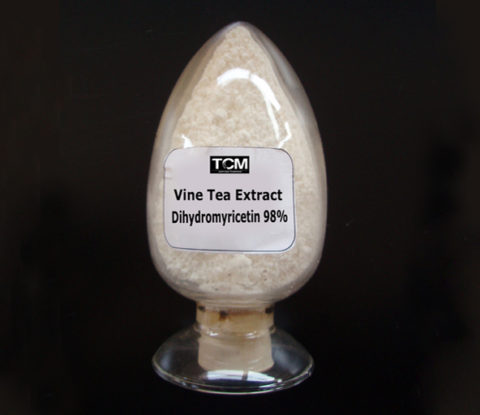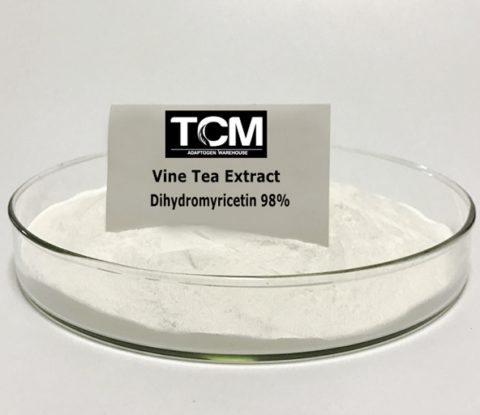
Vine Tea Extract Powder Dihydromyricetin 98% HPLC
Dihydromyricetin, also known as Ampelopsin which can work as a sobering agent if taken immediately after drinking as well as to prevent the following day’s hangover.
Vine Tea Extract/Dihydromyricetin 98%
【Botanical Source】: Ampelopsis grossedentata
【Part Used】: Leaves
【Specification】: Dihydromyricetin 98% HPLC
【CAS NO. 】:27200-12-0
【Molecular Formula】: C15H12O8
【Molecular Weight】: 320.25
【Appearance】:White fine powder
【Packing】: 1kg,2kg,5kg/bag (packed in an aluminum foil bag outside; double-layer PE inside); 25kg/fiber drum.
【Physicochemical index】:
Heavy Metal <10ppm(As <1ppm, Pb <2ppm, Hg <0.2ppm);
Pesticides Residues <1ppm;
Total Plate Count <1000cfu/g (Yeast & Mould <100cfu/g, Salmonella: Negative, E.Coli: Negative).

Dihydromyricetin, also known as Ampelopsin, is a flavanonol, a type of flavonoid. It is found in the Ampelopsis species japonica, megalophylla, and grossedentata; Cercidiphyllum japonicum; Hovenia dulcis; Rhododendron cinnabarinum; some Pinus species; and some Cedrus species, as well as in Salix sachalinensis. Our dihydromyricetin is extracted and isolated from Ampelopsis grossedentata which is traditionally used as a type of tea to treat pyretic fever and cough, pain in pharynx and larynx, and jaundice hepatitis in the south of China.
Recent studies have found that dihydromyricetin carries several pharmacological effects on humans such as hypoglycemic, antioxidant, anti-inflammatory, anti-tumor, and neuroprotective activities; however most noteworthy effect is the hepatoprotective activity because it can improve glucose and lipid metabolism, exert anti-inflammatory effects as well as improve the ability of the liver enzyme acetaldehyde dehydrogenase. Due to above-mentioned benefits, dihydromyricetin has increasingly aroused attention of many researchers to further study its pharmacological effects and underlying mechanisms in recent years.
Pharmacological Activities of Dihydromyricetin
Anti-bacterial and anti-inflammatory activities
As a broad-spectrum anti-bacterial medicine, dihydromyricetin has been used to treat inflammatory diseases for many years. Dihydromyricetin has a strong inhibitory effect on Staphylococcus aureus, Bacillus subtilis as well as on other pathogenic microorganisms such as Aspergillus flavus, penicillium and transport streptavidin(Pharmacological potential of ampelopsin in Rattan tea; Xianjuan Koua,Ning Chen). In another experiment, dihydromyricetin was proved can help to inhibit acute or sub-acute inflammation including croton oil-induced auricular edema or formaldehyde-induced paw edema in mice, and carrageenan-induced paw edema in rats, as well as abdominal capillary permeability(Effect of ampelopsin on anti-inflammation and analgesic; Fujian Journal of Medicine, 17 (4) (1995), pp. 39-41).
Interleukin-1 beta and tumor necrosis factors as inflammatory cytokines could positive regulate the production of nitric oxide and prostaglandin E2; which thus could stimulate the activity of inducible NO synthase, cyclooxygenase-2 and microsomal PGE synthase-1 in target cells. In a vivo study, dihydromyricetin was been discovered can inhibit nitric oxide production in lipopolysaccharide (LPS)-stimulated RAW264.7 macrophages and reduce carrageenan-induced acute inflammation(Miyabenol inhibits LPS-induced NO production via IKK/IkappaB inactivation in RAW 264.7 macrophages: possible involvement of the p38 and PI3K pathways; Journal Agricultral and Food Chemistry, 56 (19)(2008), pp. 8911-8918). Dihydromyricetin not only could reduce the pro-inflammatory mediators production such as IL-1β, IL-6 and TNF-αbut also could inhibit the activity of iNOS. By suppressing the mRNA and protein expression of iNOS, it could selectively inhibit the production of iOS in LPS-stimulated macrophages and RAW264.7 cells.
As a sensitive transcription factor to regulate the genes that responsible for both innate and adaptive immune response, nuclear factor-kappaB has been regarded as a major factor participated in the regulation of pro-inflammatory cytokines including iNOS and COX-2(A. Hoffmann, D. Baltimore;Circuitry of nuclear factor kappaB signaling; Immunological Reviews, 210 (4) (2006), pp. 171-186). Nuclear factor-kappaB usually exists in the cytoplasm linked with its inhibitor I-κB. Nuclear factor-kappaB will be phosphorylated and then translocated to the nuclei when inhibitor I-κB is released. The inhibitory effect of dihydromyricetin on the induction and expression of iNOS is partially mediated through inhibiting NF-κB activity and reducing the expression of the p65 subunit of NF-κB in RAW264.7 cells under stimulation by LPS(S. Qi, et al. Ampelopsin reduces endotoxic inflammation via repressing ROS-mediated activation of PI3K/Akt/NF-kappaB signaling pathways; International Immunopharmacology, 12 (1)(2012), pp. 278-287). MAPKs and PI3K/Akt are involved in the induction of pro-inflammatory genes in activated macrophages(S. Kao, et al. Lipoteichoic acid induces nuclear factor-kappaB activation and nitric oxide synthase expression via phosphatidylinositol 3-kinase, Akt, and p38 MAPK in RAW 264.7 macrophages; Immunology, 115 (3) (2005), pp. 366-374). However, dihydromyricetin can exert significant inhibition of the PI3K/Akt signaling pathway without altering the activation of MAP kinases. Moreover, PI3K may act as an upstream regulator of IKK/NF-κB activation, and dihydromyricetin can inhibit NF-κB-regulated pro-inflammatory gene expression by blocking the PI3K/Akt/NF-κB signaling cascades.
Hepatoprotective Activity
In a double-blind clinical trial, 60 adult nonalcoholic fatty liver disease patients were randomly assigned to receive either two dihydromyricetin or two placebo capsules (150 mg) twice daily for three months. The serum levels of alanine, aspartate aminotransferase, γ-glutamyl transpeptidase, glucose, low-density lipoprotein-cholesterol and apolipoprotein B, and the homeostasis model assessment of insulin resistance (HOMA-IR) index were significantly decreased in the dihydromyricetin group compared with the placebo group. In the dihydromyricetin group, the serum levels of tumor necrosis factor-alpha, cytokeratin-18 fragment and fibroblast growth factor 21 were decreased, whereas the levels of serum adiponectin were increased at the end of the study. This study showes that dihydromyricetin supplementation improves glucose and lipid metabolism as well as various biochemical parameters in patients with nonalcoholic fatty liver disease, and the therapeutic effects of dihydromyricetin are likely attributable to improved insulin resistance and decreases in the serum levels of tumor necrosis factor-alpha, cytokeratin-18, and fibroblast growth factor 21(Dihydromyricetin improves glucose and lipid metabolism and exerts anti-inflammatory effects in nonalcoholic fatty liver disease: A randomized controlled trial; Pharmacol Res. 2015 Sep;99:74-81. doi: 10.1016/j.phrs.2015.05.009. Epub 2015 May 30.).
Anti-Alcohol Intoxication Activities
Alcohol use disorders (AUD) represent a substantial public health problem worldwide. Over 76 million people present with AUD; 2.5 million deaths were attributed to alcohol (WHO, 2010). The development of AUD involves repeated alcohol use leading to tolerance, withdrawal syndrome (AWS) including hyperexcitability, distress, anxiety, insomnia, agitation, occasional seizures, a n d dependence (Trevisan et al., 1998; Heilig et al., 2010). Only an estimated 13% of people with identified AUD have ever received specialty treatment due to the lack of effective medications that ameliorate AWS and cure alcohol dependence. There is an urgent need for the development of new, more effective medications(http://grants1.nih.gov/grants/guide/pa-files/PA-10-100.html).
Although alcohol (EtOH) ingestion impacts most organ systems, its effects on the brain are of vital importance to AUD, given EtOH’s many neuropharmacological actions, including its intoxicating, sedative, anxiolytic, reinforcing, and addictive properties (Hobbs et al., 1996; Paul, 2006). EtOH alters the balance between γ-aminobutyric acid (GABA), the primary inhibitory neurotransmitter, and glutamate, the major excitatory neurotransmitter in CNS underlying the development of AUD (Mukherjee et al., 2008). GABAA receptors (GABAARs)-mediated inhibition is enhanced by acute EtOH (Aguayo et al., 2002; Koob, 2004; Lovinger & Homanics, 2007), with effects reported for both presynaptic increased GABA release (Siggins et al., 2005; Weiner and Valenzuela, 2006) and direct enhancement of GABAARs in the postsynaptic cell (Morrow et al., 1990; Boehm et al., 2004;Wallner and Olsen, 2008). GABAAR formed from a family of subunits exhibit different sensitivities to EtOH and are located either in post- or extra-synaptic membranes; this is a dynamic state with regulated trafficking between pools (Olsen and Homanics, 2000; Wallner et al., 2003; Lovinger and Homanics, 2007). ExtrasynapticGABAARs are sensitive to blood EtOH concentrations reached during social drinking (Devaud et al., 1997; Wei et al., 2004; Hanchar et al., 2005; Liang et al., 2006). Chronic EtOH administration to rats produces profound GABAAR plasticity which contributes critically to EtOH withdrawal and dependence (Liang et al., 2004, 2006,2009; Morrow et al., 2008; Olsen and Spigelman, 2011). After acute EtOH exposure, some GABAARs are down-regulated rapidly, which, with compensatory GABAAR plasticity produces altered physiology and pharmacology consistent with signs of tolerance and withdrawal exhibited in vivo (Liang et al., 2007; Shen et al., 2011). EtOH-induced behavioral changes and GABAAR plasticity can be utilized as a screen for drugs that ameliorate AUD.
Hovenia dulcis is listed among the premier anti-hangover herbal medicines in China’s first pharmacopoeia, Tang Materia Medica. Hovenia extracts ameliorate alcohol-induced liver injuries (Du et al., 2010), and relieve hangover, partly by promoting EtOH elimination via enhancement of alcohol dehydrogenase (ADH) and acetaldehyde dehydrogenase (ALDH) activity (Kim et al., 2000; Chen et al., 2006). However, its true efficacy, active constituents, and mechanisms of action have not been critically examined.
Here we demonstrate that dihydromyricetin (DHM), a flavonoid component from Hovenia, is highly effective in counteracting acute EtOH intoxication, EtOH exposure/withdrawal-induced GABAAR plasticity and AWS symptoms, as well as reducing excessive EtOH consumption. We provide strong evidence that DHM is a candidate for development as a novel AUD therapy. (Dihydromyricetin As A Novel Anti-Alcohol Intoxication Medication; J Neurosci. 2012 Jan 4; 32(1): 390–401. doi: 10.1523/JNEUROSCI.4639-11.2012).
Dihydromyricetin Dosage
The typical commercial dose of Dihydromyricetin is 300 mg per capsule. It is suggested to take 1 – 2 capsules for a total of 600 mg, to counteract the effects of up to 6 servings of hard liquor. This dosage can produce sobering effects if taken immediately after drinking as well as to prevent the following day’s hangover.






